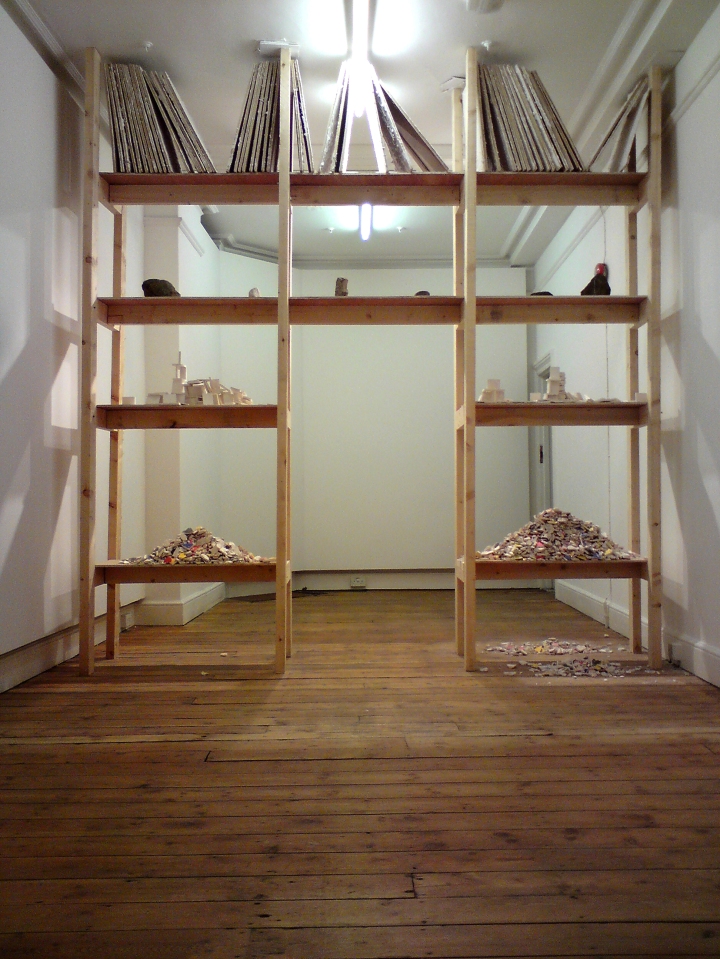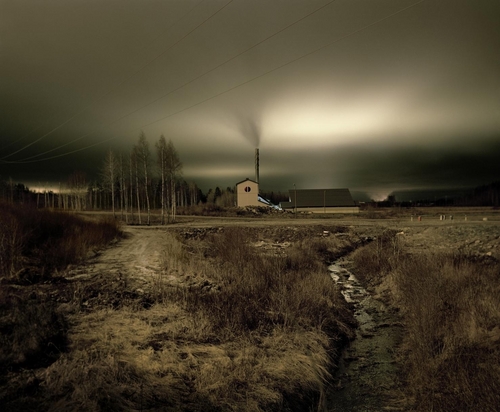Mount Zion, William Corwin

William Corwin’s Mt Zion has just opened at the recently relocated George and Jorgen. Though a bit off-street, the gallery seems much more at home in London Bridge than it did above the Salvo off Regent Street.
It’s the industrious New York artist’s second solo show in London, and already his distinctive visual language has emerged. We make the journey to Mt Zion expecting some kind of revelation, of course. The smell of MDF and plaster, the absence of colour, and the clean lighting immediately convey that the basic framework and the bare bones are what concern us here.
Near the entrance invisible chess boards decorate the wall; skeletal fragments of plaster are neatly arranged on clean processed wood. These simple, slightly crap objects act as a thematic introduction to the main event.
In the first large space is the altar set piece. Giant chess pieces King and Blue Boy flank the altar. In his last show, alans wood, Corwin’s scattered white cuboids took on the character of toy-town Armageddon. Here they take on a much larger scale.
At two feet tall, chess pieces start to look like chess players, with their own goals and ideas about where they might move. They are assembled around a small icon, a blueprint for their chaotic construction.
Corwin is trying to evoke the deep sense of self-reflection that comes with entering a holy place. In this mood, you arrive the last room. It’s like the crypt of a Cathedral or the dimly lit recesses where museums keep only their most ancient and precious artefacts.
Gallery viewers slowly circulate in reverent silence, around Lucy, a representation of Donald Johanson’s 1978 discovery, Australopithecus Aferensis, the mother of modern man. Through the study of her bones, or the veneration of her corpse, we can discover a lot about ourselves.
Corwin has been artist in residence at the Clocktower Gallery, New York, and at the Centre For Recent Drawing in London. He has appeared all over New York and, internationally, he has exhibited in Beijing, Taiwan and Hamburg.
In 2013 he is teaming up with urban planner Neil Greenburg to create a large scale sculptural game that will inhabit Staten Island Ferry Terminal. His largest work yet, it will be viewed by 65,000 daily.
I will look forward to seeing William Corwin get the opportunity to take on projects of such size. He has established a manifesto and should take it further. It is worth taking a trip to Mt Zion: it may prove to be a prophetic exhibition.
Will Corwin’s Mt Zion is on at George and Jorgen 9 Morocco Street, London, SE1 3HB until 27th May 2012
Published on the Spectator Arts Blog
William Corwin at George and Jørgen

William Corwin – The Last Judgement (2011)
Extremely abstract installation work can be a tough beast to grapple with, but, well conceived, common themes and meanings can always emerge. This is very much the case as New York sculptor William Corwin holds his first London show under the title alans wood at George and Jørgen Gallery this month. The exhibition consists of two site-specific installations and a small collection of drawings and sculptures.
At first it’s hard to know what to make of all the crude shelves and boxes that stick out of the walls, but Corwin’s artwork slowly reveals a witty commentary on our habits of categorising and containing concepts in arbitrary ways.
The Last Judgement, which dominates most of the space, is based on the mosaic in the Cathedral of St Maria in Torcello, Venice. The original mural divides humanity into neat little compartments with the trinity and the angels above, then the saints, mortals and at the bottom, sinners. Corwin has constructed a similarly composed set of shelves, upon which he imposes his personal hierarchy of building materials: at the top, his divine plaster board, followed by uncut stone, geometrically moulded plaster, and then hand-painted rubble at the bottom. He says that this hierarchy is irrelevant, or at least impenetrable, as it means something only to him.
Corwin’s drawing also parodies man’s tendency to catalogue. His sketches record types of cloud, each one outlined by a square box, with overlaid Rorschach blots. The overlapping of these nebulous forms highlights the subjectivity of interpretation. “I’m sure these cloud types are useful to pilots and meteorologists,” Corwin explains, “but when you look up at the sky you see a cloud that maybe looks like a bus, or a train. Similarly you might see anything in a Rorschach blot, but on the back of the card it says that if you see an axe then you’re mental.”
Clearly the human instinct to find patterns and definitions, even in that which seems to be formless, as in a cloud, crowd or ink blot, is of great amusement to Corwin. The bureaucracy of both science and religion is made to look silly and awkward by his work. Diet of Worms sticks out into the centre of the room and The Last Judgement partitions off the empty back of the gallery like a rood screen in a church. The result is that gallery-goers have to navigate through awkward spaces and end up hemmed into the front of the room. Because there is nothing on the other side of The Last Judgement, that space is left uninhabited, and the viewers find themselves boxed in alongside the rest of the compartmentalised artwork. This very literal experience of partitioning mirrors the overall point that Corwin seems to be making.
Both George and Jørgen seem to have really enjoyed the show, partly because they helped to build a significant amount of the installations. George tells me that he finds the contrast with their last show particularly refreshing, and he’s pleased to see his small contribution on display. As a viewer, I too am enthused by their participation, and would recommend a peek if you come by. It may take some time to get the joke, but when you do, it more than rewards the effort.
William Corwin – alans wood is at George and Jørgen until 2nd April 2011.
Published on Spoonfed.co.uk
Documenting the Imagination
There is a snobbery surrounding photographic manipulation and post-production, particularly in the digital realm. Extravagant Photoshopping is widely held to be the domain of pornographers, hoaxers and cheats. But the idea that that the process of photography should essentially stop once the shutter has been released closes the door to a world of creative possibility. Exploration and Intervention: New Landscape Photography, at the George and Jorgen Gallery, does its very best to confound such traditionalist attitudes.
Young exhibiting artists Peter Ainsworth, Alejandro Guijarro, Martina Lindqvist, Byron Pritchard and Kurt Tong, ensure there is a diverse selection of both digital and film photography hanging up. The connection between landscape and exploration is a given: the two are mutually dependent. But intervention is not so obviously compatible with the values of either landscape or photography; aren’t we supposed to take the role of an objective observer? What is all this heretical meddling? You can’t do that – it’s not real!

Martina Lindqvist – A Thousand Little Suns I(2010)
Landscape photography, though lovely, is rarely very exciting, but the techniques with which these artists have ‘intervened’ elevates the show way above the glut of Alpine sunsets and night time cityscapes that swamp offices and coffee tables worldwide. Swedish-Finnish artist Martina Lindqvist, for example, has produced three twilight landscapes (A Thousand Little Suns I, II and III) of ethereal beauty. The scenes seem to be lit by an omnipotent, eerie sort of stage lighting: or a thousand little somethings? Irregular points of focus pull the eye this way and that; the length of exposure has smoothed the grey luminescent skies into a superficial, dreamy backdrop, and desaturated the crisp geometric form of the factory. The result gently involves you in a landscape of brooding pathetic fallacy and solitary introspection. George Lionel Barker (as in ‘…and Jorgen’) says Lindqvist is very secretive about how she creates her images, and is clearly delighted but a little confused by the piece; these works tap into the lifeblood of the show’s theme. ‘It’s very Scandinavian,’ a Swede standing next to me confidently asserts.
Byron Pritchard exhibits two quite surreal renderings of plant life, shooting with regular film and then subjecting his massive developed images to a series of chemical treatments. After developing in black and white, he then bleaches the image, adds toner, paints masking fluid over the lightest spots, adds another toner, and then washes the surface with translucent oil paints. The process is messy and expensive, but the result is rich and engaging.
Inspired by Hans Bellmer, Pritchard laments that photo tinting has never been taken seriously in high art, reminding me of the historic aversion to ‘intervening’ in photography. Alejandro Guijarro’s landscapes are of particular note: mist envelopes the horizon; only the very foreground is discernible. The repeated patterns of the Asian temple could carry on forever as they fade into the near distance, prompting the imagination to fill in the gaps.
As a whole, Exploration and Intervention challenges the idea that a photograph should retain at least some documentary purpose, that a landscape should represent a point on the map. The works on show emphasise that photography is a process that takes place long before and after the moment of capture. These fictitious and abstract landscapes are extremely beautiful and provide a whole new menu of food for thought. It is only George and Jorgen’s second show, and the gallery holds much promise for the future.
Exploration and Intervention: New Landscape Photography runs until March 11 at George and Jørgen, 9a Princes Street, London W1B 2LQ.
Published on the Spectator Arts Blog.






leave a comment